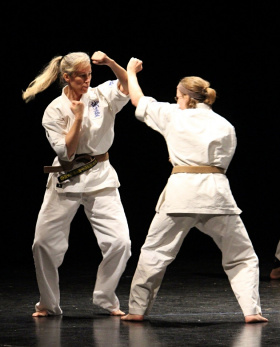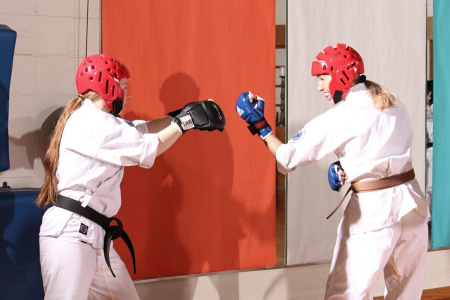2020 February
2018 December August June February
2017 December September June March
2016 November August June March
2015 December October July May February
2014 December October July April February
2013 December October August May February
2012 December September July April February
2011 December September July April February
from the October, 2015 issue of Kiai!
Learning to Like Sparring
By Tabitha Balakumar
Advanced Brown Belt
From the start, people usually love or hate sparring – there is very little in between. This can stem from many different things: sparring might seem freeing to some people because nothing is pre-set the way it is in kata. Others might find that concept daunting because they prefer to know what is going to happen next and sparring isn’t conducive to that. Some people simply don’t like getting hit, and others don’t like to do the hitting.

Tabitha demonstrates sparring curriculum with Erin
during the Art With Heart performance.
I fall into that last category. I don’t like hurting people. In fact, I dislike it so much that I’d rather take the pain onto myself instead of watch someone else go through it. When I first started training, I thought the point of punching was to inflict pain on other people. That’s what I saw all around me while growing up, and I carried that into adulthood. At Thousand Waves, the point of sparring isn’t to inflict pain, but rather to play a game. I didn’t know that, so I avoided the sparring skills class like the plague.
I couldn’t avoid it forever, of course, so I eventually mustered up the courage to go. In my first class, I didn’t hit anyone. I defended and wasn’t bothered when I got hit, but I couldn’t bring myself to extend a punch toward another person. In my second class, Senpai Yesica made me do it. She didn’t just tell me I had to; she actually stood there and watched until I did it. That said, my first punch wasn’t really a punch. It was more like moving with dynamic tension – really slow and ridiculous. I hated every second of it, and I never wanted to spar again.
Obviously, I didn’t quit. I kept making myself go to sparring and even began to improve, but I still hated it. The fear of hurting my partner was always up front and center, and I erred way too much on the side of caution. I decided that I had to look at sparring differently. I had to see it as a game where no one wins and no one keeps score. I set tiny goals to make contact at least once in each round, then twice, then three times, etc.
I also did drills outside of class with a trusted partner: one person up against a wall defending, and the other attacking. It got me more comfortable with hitting my partner, especially since they never got hurt. Actually, this drill is useful for anyone who doesn’t like sparring. If you don’t like getting hit, this gives you practice taking contact in a controlled manner, which means you won’t get hurt. If you struggle with not knowing what’s going to happen next, this gives you practice adjusting to the unexpected. Eventually, you’ll be able to stay relaxed when something discomforting happens. When you’re relaxed, you can react more safely.

Tabitha spars with a trusted partner, Senpai Mattie during Spirit Challenge.
If you practice with a trusted partner, you will gradually get used to the things you find uncomfortable. It requires time and dedication, but it works. Since our entire martial practice requires time and dedication, this isn’t a new concept. In fact, it makes sense to work on the areas we don’t like even more than those we do like.
I still don’t love the overall concept of sparring, but I like it now. The more I spar, the more I like it. I’m sure that, with time and dedication, I’ll get to the point where I love it.
